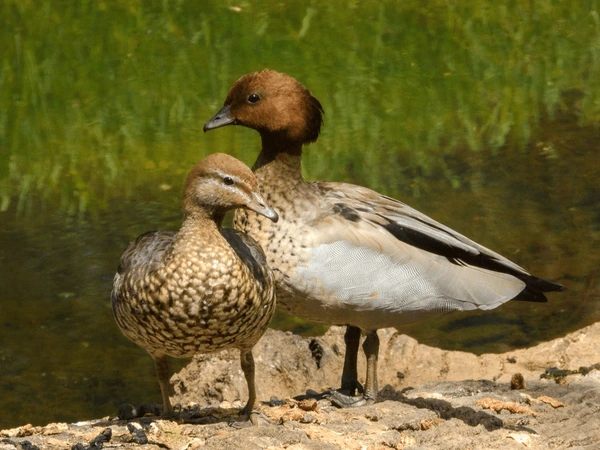Maned Duck

Scientific Name
Chenonetta jubata
Alternative Names:
Australian Wood Duck, Maned Duck, Maned Goose
Measurements:
| Feature | Male | Female |
|---|---|---|
| Length | 45–51 cm (18–20 in) | 45–51 cm (18–20 in) |
| Weight | 1.0–1.2 kg (2.2–2.6 lb) | 0.9–1.1 kg (2.0–2.4 lb) |
| Wingspan | About 80 cm (31 in) | About 80 cm (31 in) |
Status
Common and widespread across Australia. Not threatened. The species has adapted well to farmland, parks, and urban areas.
Identification
The Australian Wood Duck looks like a small goose. The male has a dark brown head, grey body, and fine black-and-white lines on the sides. The female is lighter, with white stripes above and below the eye and a mottled breast. Both have grey wings with a white patch and black tips. Juveniles look similar to females but are lighter in color.
Voice
Females make a loud, rising “gnow” call. Males give a smoother, shorter, and higher call. Groups often make chattering sounds when flying or feeding.
Diet
They mostly feed on land, eating grasses, clover, grains, and small herbs. Occasionally, they eat insects. Unlike many ducks, they rarely swim while feeding.
Distribution
Found all over mainland Australia and Tasmania. Sometimes seen in New Zealand. Common around farms, city parks, golf courses, and wetlands with nearby grassy areas.
Habitat
Prefers open grassy areas near water—such as lakes, ponds, rivers, and flooded fields. They also thrive in farmland and urban spaces where water and grass are easily available.
Breeding
The female nests in tree hollows or nest boxes, often above water. She lays 9–11 cream-colored eggs and lines the nest with down. The male guards the nest. When the ducklings hatch, they jump from the nest to the ground and follow both parents.
Behavior
Usually seen grazing in pairs or small groups, though they form larger flocks in open fields. They are alert and quick to take flight if disturbed.
Conservation
The Australian Wood Duck population is stable and even increasing due to its ability to live near humans. It is listed as a game bird in several Australian states, where controlled hunting is permitted.
